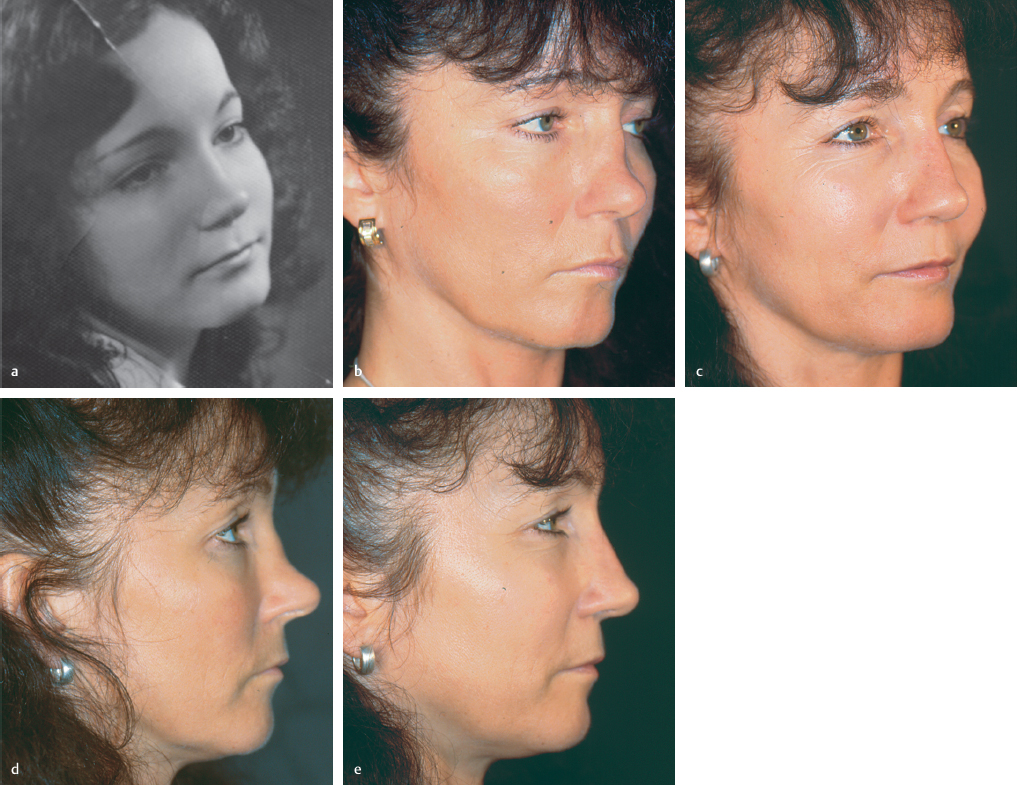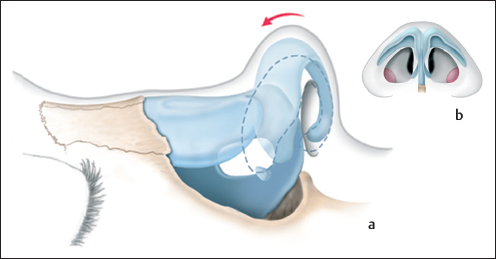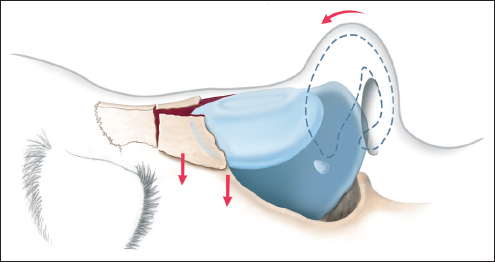Chapter 12 12.4 Preoperative Preparations and Prerequisites 12.7 Guidelines for Tissue Replacement in the Nose 12.8 Principles of Implantology in the Nose The term saddle nose denotes a polycausative condition that is associated with destabilization or destruction of the bony or cartilaginous structures of the nose. In old textbooks on otorhinolaryngology, saddle nose was most often described as a feature of congenital syphilis.1 Today, osseous forms of saddle nose are rare and usually result from dysplasia of the nasal bones or from nasal or midfacial trauma. The cartilaginous saddle nose is a more frequent concern for rhinologists. The central problem in this condition is serious structural compromise caused by a loss of anterior septal cartilage between the rhinion (keystone area) and the “septal pedestal” at the level of the premaxilla and anterior nasal spine.2 Frontal trauma to the nose can lead to septal cartilage necrosis as a result of septal hematoma or septal abscess. Meanwhile, cartilage fragments may be displaced and weaken the mechanical properties of the septal cartilage or may produce a sharp, angular septal deviation or transverse deviation. Combined injuries to the bony and cartilaginous nose lead to lateralization of the nasal bones or portions of the maxillary frontal process. This creates an open roof, often with disruption of the osseocartilaginous junction at the rhinion (keystone) and the formation of a visible step-off (inverted V) between the cartilaginous and bony nasal segments. Cartilaginous saddle nose can also result from the over-resection of septal cartilage in a septoplasty—a common legacy from the age when the Killian’s resection was widely practiced. Depending on their size and location, septal perforations cause a loss of cartilage substance, leading to concavity of the cartilaginous nasal dorsum and retraction of the lower columella (“hidden columella”). Other causes may be Wegener’s granulomatosis, cocaine abuse, trauma from nose picking, atrophic rhinitis sicca (often combined with an anterior septal deviation), or polychondritis.3 A change in the septal cartilage is almost never the sole cause of saddle nose, however. Saddling is a multifactorial process in which the destabilization of the septum incites changes such as separation or settling of the upper lateral cartilages, and cranial tip rotation or loss of tip projection and support. For this reason, stable reconstruction of the cartilaginous septum is the critical challenge in the operative treatment of saddle nose deformity. Saddle nose is a typical example of the inseparable link between morphological and functional abnormalities in the nose and the task that is faced by corrective nasal surgery. The depression of the supratip area leads to widening of the nasal valve with a caudal drift of the upper lateral cartilages. The increased nasal valve angle is accompanied by hyperplasia of the inferior turbinates (ballooning phenomenon). The result of these changes is always an impairment of nasal breathing. The surgical treatment of saddle nose has a reconstructive character. Many patients will bring in old photographs of themselves to demonstrate the original shape of their nose. In contrast to most other operations in aesthetic nasal surgery, where the object is to modify an existing form, the usual goal in saddle nose surgery is the restoration of a former state (Fig. 12.1). The surgery of saddle nose requires expertise in the selection, procurement, and placement of suitable grafts or implants for tissue replacement in the nose (see the section on Guidelines for Tissue Replacement in the Nose later in this chapter). Many different techniques have been described for the surgical correction of saddle nose. The state of the art is particularly well represented by the works of Tardy, Meyer, Rettinger, Nolst Trenité, Aiach, and others.4–8 The goal of a saddle nose correction is not just to reconstruct the nasal dorsum. A more important goal is to restore the supportive framework of the nose in order to improve nasal breathing and achieve stable long-term results. Form and function are almost always equally compromised in saddle nose deformity, and both must be included in the plan of operation in order to achieve acceptable results. Our discussion of functional and aesthetic indications in separate sections is done purely for didactic reasons. The indication for septorhinoplasty on functional grounds is based largely on the degree of nasal breathing impairment. Severe impairment often leads to pathological sequelae such as pharyngitis, laryngitis, and bronchitis. Septal deformities, usually following septal fractures, lead to paranasal sinus ventilation problems with recurrent or chronic sinusitis, which in turn may cause headaches and facial pain. Septal perforations can cause drying of the mucosa and olfactory compromise, depending on their size. Saddling leads to typical external changes in the nose relating to depression of the cartilaginous dorsum, especially in the supratip area. Depending on the cause, there are typical pathogenic mechanisms that affect the face as a whole and especially the proportions of the profile. Fig. 12.2 illustrates these typical changes in a woman with posttraumatic saddle nose. The frontal view demonstrates a broadened nasal dorsum. The rhomboid of the nasal tip is broadened. We look in vain for the supratip point formed by the anterior septal angle. The result is a broad, poorly defined tip. A hidden columella is apparent in the frontal view. The infratip triangle is shortened. The result is a general coarsening of the facial features. The lateral view shows saddling of the nasal dorsum in the supratip area. The tip is rotated upward and has lost projection. As a result, the chin appears to jut forward. A pseudosaddle nose is caused by an overprojected tip combined with a concave nasal dorsum. The facial circle is useful for determining the position of the tip and helps in differentiating between a true and pseudosaddle nose (see Chapter 5). A pseudohump occurs when the cartilaginous nasal dorsum is depressed below the rhinion. In contrast to a true hump, the nasofrontal angle is not increased. The hidden columella is most apparent in the three-quarter profile view (Fig. 12.2a–f). Contraindications for septorhinoplasty exist in patients with florid granulomatous inflammations that have caused cartilaginous destruction, as in Wegener’s granulomatosis or polychondritis. The top priority in these cases is to diagnose the underlying disease. It is often difficult to make a histological diagnosis in Wegener’s disease. The excisional biopsy should always be taken from the margin of the septal perforation and should include normal-appearing mucosa along with the granulations. If possible, reconstruction should be deferred until remission has been achieved with pharmacological therapy. Pirsig et al reported on the successful reconstruction of saddle nose in cases of Wegener’s granulomatosis and ectodermal dysplasia using extranasal incisions and auricular cartilage.9 Saddle nose reconstruction following a prior septal operation is most successful when it is delayed for approximately 9 months after the initial surgery so that the new operation can be planned on the basis of definitive, scarred defects. Operating too early before wound healing is complete and stabilizing or destabilizing the result of the previous operation will also jeopardize the revision outcome. Traumatic saddle nose in boxers should not be corrected until the patient has retired from the ring. Often, however, professional boxers will already have problems with obstructed nasal breathing at the start of their career. In these cases, a compromise may be struck between functional improvement and reasonable aesthetic improvement without extensive mobilization of the nasal skeleton. History taking in saddle nose patients should include any prior history of trauma. Besides the mechanism of a nasal injury, the timing of the injury provides important causative clues. If the trauma affects the cartilaginous growth zones of the pediatric nose, saddling may result from the inhibited growth of specific nasal cartilages. The traumatized adult nose is characterized by the displacement of initially normally developed cartilages. The rhinological history should also probe for signs of cartilaginous diseases, previous nasal operations, and underlying diseases. Saddle noses present characteristic external features that vary with the underlying pathogenic mechanisms. The following changes may be seen as isolated findings or in various combinations. The nose appears generally broadened. This may be most conspicuous in the supratip area or may affect the entire nasal dorsum. If the nasal bones are displaced or lateralized, hypertelorism is noted. Often, this impression is strengthened by ruptured medial palpebral ligaments. Epicanthal folds result from a disproportion between the skin and the reduced nasal height. An open roof contributes to widening of the nasal dorsum. The “inverted V” is a sign that the connection between the cartilaginous and bony nose has been disrupted. The nasal dorsum is depressed. The tip is usually rotated upward or occasionally downward, causing a loss of projection. If the cartilaginous anterior septal margin is absent, the columella is retracted cephalad (hidden columella) with deformation of the alar–columellar complex. The columella is shortened. The upper lip appears too long. The nasal base and nares are broadened. The nares assume a more horizontal alignment and have a round or transverse oval shape. The columella is shortened. The angle between the septum and lateral alar cartilages is obtuse. The nasal valve is broadened. The inferior turbinates are hyperplastic, and the upper lateral cartilages show caudal displacement (ballooning phenomenon). The septum can be inspected for cartilaginous defects (soft septum) with the endoscope and a cotton applicator. Granulations and perforations can be evaluated and biopsy specimens taken. Precise information on how much cartilage is still present is just as important as the size of a septal perforation. Important information can be gained in saddle nose patients by external and internal palpation of the nose. The nasal dorsum is palpated for irregularities, bony and cartilaginous defects, and an open roof. Trauma will often leave sharp-edged irregularities resulting from displaced fragments of nasal bones. Selection of the operative technique is guided by the palpation of tip support in connection with the anterior septal angle. Internal palpation of the nose can furnish information on the anterior septum, its anterior margin, and the presence of cartilaginous fractures or defects in the anterior septum. Saddle nose patients should be assessed with a simple blood count and basic coagulation studies (quick prothrombin time [PT], partial thromboplastin time [PTT], platelets). The blood group is not routinely determined because hemorrhage requiring a transfusion is extremely rare. If the patient should require a transfusion because of heavy bleeding, the blood group can be quickly determined in a hospital setting. In patients with septal perforations and granulomatous inflammations, interleukin 6 is a more sensitive marker than C-reactive protein in assessing the acuteness of the inflammation. If an autoimmune disease such as Wegener’s granulomatosis is suspected, the lungs should be investigated by plain radiography and computed tomography. Laboratory tests are done to check for signs of progressive renal failure (cystatin C, creatinine). When Wegener’s granulomatosis is present, tests will reveal anticytoplasmic antibodies directed against plasma granules of neutrophilic polymorphonuclear leukocytes and monocytes (ACPA/ANCA).10,11 Patients with elevated transaminases should undergo more precise coagulation testing (platelet function test) prior to surgery. Members of high-risk groups such as homosexuals, drug users, and prostitutes should be tested for HIV. Saddle nose can result from a variety of causes. Three pathogenic mechanisms have been identified for the most common types of saddle nose. Loss of nasal dorsum support from the anterior septum leads to a loss of cartilaginous dorsal height. There may be lateralization, spreading, or separation of the upper lateral cartilages, depending on the depth of the saddling. With depression of the dorsal septal margin, an important tip support mechanism is compromised. This leads to depression of the supratip area and anterior septal angle. As this occurs, the rhomboid of the nasal tip loses its supratip point, and the tip becomes amorphous. Because tip support is deficient, the tip rotates upward. If residual cartilage is preserved in the caudal septum near the caudal margin, this remnant can still provide adequate tip support. The loss of projection in the nasal tip results from cranial rotation due to deficient support of the supratip area. This cranial rotation leads to a loss of tip projection. The nasolabial angle is broadened (> 110 degrees). The loss of structural support from the septal cartilage causes the caudal portions of the lateral cartilages to sag, with broadening and deformation of the nasal valve angle (ballooning phenomenon). There is compensatory hyperplasia of the inferior turbinates. Viewed from the front, the central nasal dorsum appears broad and blends smoothly with a poorly defined tip (Fig. 12.3). This type is based on extensive cartilage defects in the septum or an absence of cartilage at the caudal septal margin. Absence of the anterior cartilaginous septum leads to a lack of support of the dorsal septal margin. There is no membranous septum to stabilize the medial crura of the alar cartilages, and the caudal septal margin is unable to secure the footplates of the medial crura. The columella is retracted upward (hidden columella). The tip loses projection due to the complete loss of tip support. The tip may rotate upward or downward, depending on whether the forces exerted by scar formation and tissue contraction act chiefly on the nasal dorsum and supratip area or the caudal septal margin. Because the depression of the cartilaginous dorsum and dorsal septal margin and the basal movement of the upper lateral cartilages create a greater loss of static support, the tip usually rotates upward, compounding the loss of projection. Fig. 12.3 (a) Cartilaginous saddle nose has resulted from cartilage loss in the area indicated, with preservation of the caudal septal margin. Note the depression of the cartilaginous nasal dorsum and the cranial tip rotation with loss of projection. (b) Typical changes in the nasal base with broadening of the nasal valve and compensatory hyperplasia of the inferior turbinates. The broadened central portion of the nose in this situation is accompanied by a broadened tip. Because of the lax membranous attachment between the upper lateral and alar cartilages, the anterior margins of the upper lateral cartilages slip downward, while the alar cartilages are displaced laterally. The columella is shortened (Fig. 12.4). Displaced fractures of the nasal bones or maxillary frontal process combined with trauma to the cartilaginous nose can disrupt the attachments of the upper lateral cartilages to the nasal bones in the keystone area. “Keystone” is an architectural term for the central stone that is wedged in place at the apex of an archway. If the keystone were removed, the archway would collapse. Describing the osseocartilaginous attachment at the level of the rhinion as the keystone area underscores the essential load-bearing importance of this area. A traumatic avulsion of the cartilaginous nose from the nasal bones leads to an inverted V-shaped depression that is difficult to correct. In contrast to the type I and II mechanisms, the cranial portion of the upper lateral cartilage or the entire lateral cartilage is shifted downward. Associated changes in the cartilaginous dorsum and nasal tip result from the mechanisms described earlier. The bony nasal pyramid is depressed, and the dorsum already appears broadened at the bony level (Fig. 12.5). Fig. 12.4 Cartilaginous saddle nose with destruction of the caudal septal margin. The lower columella is retracted upward (“hidden columella”), and the alar–columellar complex is deformed.
The Saddle Nose—Causes and Pathogenesis, Approaches and Operative Techniques, Principles of Tissue Replacement in the Nose
12 The Saddle Nose—Causes and Pathogenesis, Approaches and Operative Techniques, Principles of Tissue Replacement in the Nose
12.1 Introduction
12.2 Indications
12.2.1 Functional Indications
12.2.2 Aesthetic Indications
12.3 Contraindications
12.4 Preoperative Preparations and Prerequisites
12.4.1 History
12.4.2 Inspection
Frontal View
Lateral View
Basal View
12.4.3 Nasal Endoscopy
12.4.4 Palpation
External Palpation
Internal Palpation
12.4.5 Laboratory Tests
12.5 Preoperative Analysis
12.5.1 Type I Pathogenic Mechanism of Saddle Nose
12.5.2 Type II Pathogenic Mechanism of Saddle Nose
12.5.3 Type III Pathogenic Mechanism of Saddle Nose
Plastic Surgery Key
Fastest Plastic Surgery & Dermatology Insight Engine














